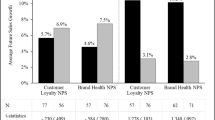Abstract
Financial statement analysis textbooks advocate disaggregating profitability into asset turnover and profit margin in performing financial analysis. In spite of the prominence of this technique, there is no evidence demonstrating its usefulness in a forecasting context. We provide evidence that disaggregating return on assets into asset turnover and profit margin does not provide incremental information for forecasting the change in return on assets one year ahead, but that disaggregating the change in return on assets into the change in asset turnover and the change in profit margin is useful in forecasting the change in return on assets one year ahead.
Similar content being viewed by others
References
Abarbanell, J. S. and B. J. Bushee. (1997). “Fundamental Analysis, Future Earnings, and Stock Prices.” Journal of Accounting Research 35 (Spring), 1-24.
Belsley, D., E. Kuh and R. Welsch. (1980). Regression Diagnostics. New York, NY: John Wiley and Sons.
Bernstein, L. and J. Wild. (1998). Financial Statement Analysis, 6th ed. Irwin-McGraw Hill.
Brooks, L. D. and D. Buckmaster. (1980). “First-difference Signals and Accounting Income Time-series Properties.” Journal of Business, Finance, and Accounting, 437-454.
Fairfield, P., R. Sweeney and T. Yohn. (1996). “Accounting Classification and the Predictive Content of Earnings.” The Accounting Review (July), 337-356.
Fairfield, P., S. Whisenant and T. Yohn. (2001). “Accrued Earnings and Growth: Implications for Earnings Persistence and Market Mispricing.” Working paper, Georgetown University.
Feltham, G. and J. Ohlson. (1995). “Valuation and Clean Surplus Accounting for Operating and Financial Activities.” Contemporary Accounting Research 11 (Spring), 689-731.
Freeman, R., J. Ohlson and S. Penman. (1982). “Book Rate of Return and the Prediction of Earnings Changes.” Journal of Accounting Research 20 (Autumn), 639-653.
Givoly, D. and C. Hayn. (1993). “Transitory Accounting Items: Information Content and Earnings Management.” Working paper, Tel Aviv University and Northwestern University.
Lipe, R. C. (1986). “The Information Contained in the Components of Earnings.” Journal of Accounting Research 24 (Supplement), 37-64.
Nissim, D. and S. Penman. (2000). “Ratio Analysis and Equity Valuation.” Working paper, Columbia University.
Ohson, J. (1995). “Earnings, Book Values and Dividends in Security Valuation.” Contemporary Accounting Research 11 (Spring), 661-687.
Ou, J. (1990). “The Information Content of Nonearnings Accounting Numbers as Earnings Predictors.” Journal of Accounting Research (Spring), 144-163.
Ou, J. and Penman, S. (1989). “Financial Statement Analysis and the Prediction of Stock Returns.” Journal of Accounting and Economics (November), 295-329.
Revsine, L., D. Collins and W. B. Johnson. (1999). Financial Reporting & Analysis. Upper Saddle River, N.J.: Prentice-Hall, Inc.
Selling, T. and C. Stickney. (1989). “The Effects of Business Environment and Strategy on a Firm's Rate of Return on Assets.” Financial Analysts Journal (January–February), 43-52.
Sloan, R. (1996). “Do Stock Prices Fully Reflect Information in Accruals and Cash Flows about Future Earnings?” The Accounting Review (July), 289-315.
Stickney, C. and P. Brown. (1999). Financial Reporting and Statement Analysis, 4th ed. New York: Harcourt, Brace & Co.
Sunder, S. (1980). “Corporate Capital Investment, Accounting Methods, and Earnings: A Test of the Control Hypothesis.” The Journal of Finance (May), 553-568.
Author information
Authors and Affiliations
Rights and permissions
About this article
Cite this article
Fairfield, P.M., Yohn, T.L. Using Asset Turnover and Profit Margin to Forecast Changes in Profitability. Review of Accounting Studies 6, 371–385 (2001). https://doi.org/10.1023/A:1012430513430
Issue Date:
DOI: https://doi.org/10.1023/A:1012430513430




